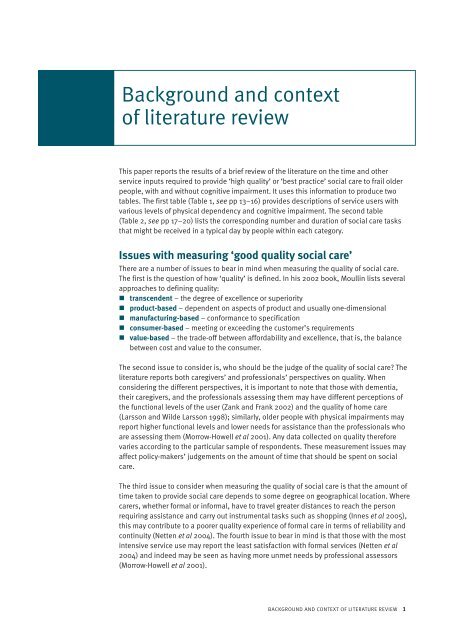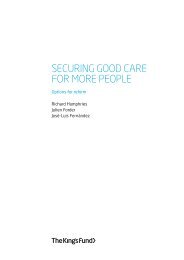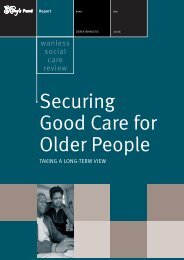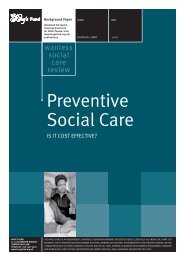Time and other inputs for high quality social care - The King's Fund
Time and other inputs for high quality social care - The King's Fund
Time and other inputs for high quality social care - The King's Fund
Create successful ePaper yourself
Turn your PDF publications into a flip-book with our unique Google optimized e-Paper software.
Background <strong>and</strong> context<br />
of literature review<br />
This paper reports the results of a brief review of the literature on the time <strong>and</strong> <strong>other</strong><br />
service <strong>inputs</strong> required to provide ‘<strong>high</strong> <strong>quality</strong>’ or ‘best practice’ <strong>social</strong> <strong>care</strong> to frail older<br />
people, with <strong>and</strong> without cognitive impairment. It uses this in<strong>for</strong>mation to produce two<br />
tables. <strong>The</strong> first table (Table 1, see pp 13–16) provides descriptions of service users with<br />
various levels of physical dependency <strong>and</strong> cognitive impairment. <strong>The</strong> second table<br />
(Table 2, see pp 17–20) lists the corresponding number <strong>and</strong> duration of <strong>social</strong> <strong>care</strong> tasks<br />
that might be received in a typical day by people within each category.<br />
Issues with measuring ‘good <strong>quality</strong> <strong>social</strong> <strong>care</strong>’<br />
<strong>The</strong>re are a number of issues to bear in mind when measuring the <strong>quality</strong> of <strong>social</strong> <strong>care</strong>.<br />
<strong>The</strong> first is the question of how ‘<strong>quality</strong>’ is defined. In his 2002 book, Moullin lists several<br />
approaches to defining <strong>quality</strong>:<br />
• transcendent – the degree of excellence or superiority<br />
• product-based – dependent on aspects of product <strong>and</strong> usually one-dimensional<br />
• manufacturing-based – con<strong>for</strong>mance to specification<br />
• consumer-based – meeting or exceeding the customer’s requirements<br />
• value-based – the trade-off between af<strong>for</strong>dability <strong>and</strong> excellence, that is, the balance<br />
between cost <strong>and</strong> value to the consumer.<br />
<strong>The</strong> second issue to consider is, who should be the judge of the <strong>quality</strong> of <strong>social</strong> <strong>care</strong>? <strong>The</strong><br />
literature reports both <strong>care</strong>givers’ <strong>and</strong> professionals’ perspectives on <strong>quality</strong>. When<br />
considering the different perspectives, it is important to note that those with dementia,<br />
their <strong>care</strong>givers, <strong>and</strong> the professionals assessing them may have different perceptions of<br />
the functional levels of the user (Zank <strong>and</strong> Frank 2002) <strong>and</strong> the <strong>quality</strong> of home <strong>care</strong><br />
(Larsson <strong>and</strong> Wilde Larsson 1998); similarly, older people with physical impairments may<br />
report <strong>high</strong>er functional levels <strong>and</strong> lower needs <strong>for</strong> assistance than the professionals who<br />
are assessing them (Morrow-Howell et al 2001). Any data collected on <strong>quality</strong> there<strong>for</strong>e<br />
varies according to the particular sample of respondents. <strong>The</strong>se measurement issues may<br />
affect policy-makers’ judgements on the amount of time that should be spent on <strong>social</strong><br />
<strong>care</strong>.<br />
<strong>The</strong> third issue to consider when measuring the <strong>quality</strong> of <strong>social</strong> <strong>care</strong> is that the amount of<br />
time taken to provide <strong>social</strong> <strong>care</strong> depends to some degree on geographical location. Where<br />
<strong>care</strong>rs, whether <strong>for</strong>mal or in<strong>for</strong>mal, have to travel greater distances to reach the person<br />
requiring assistance <strong>and</strong> carry out instrumental tasks such as shopping (Innes et al 2005),<br />
this may contribute to a poorer <strong>quality</strong> experience of <strong>for</strong>mal <strong>care</strong> in terms of reliability <strong>and</strong><br />
continuity (Netten et al 2004). <strong>The</strong> fourth issue to bear in mind is that those with the most<br />
intensive service use may report the least satisfaction with <strong>for</strong>mal services (Netten et al<br />
2004) <strong>and</strong> indeed may be seen as having more unmet needs by professional assessors<br />
(Morrow-Howell et al 2001).<br />
BACKGROUND AND CONTEXT OF LITERATURE REVIEW 1
















